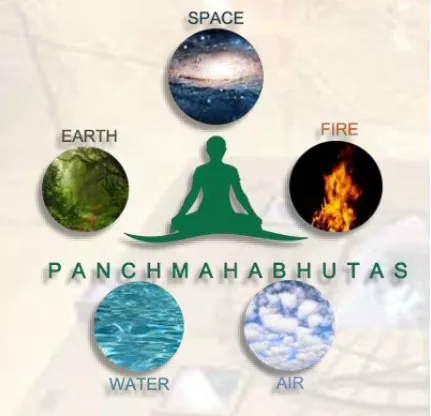Within a complex tapestry of existence, where the universe takes place its boundless mysteries, the concept of the five elements of nature emerges as a timeless thread, weaving through cultures, philosophies, and disciplines all over the world. In ancient Indian wisdom, these elements – earth, water, fire, air, and ether – are known as PanchaMahabhuta and serve as the foundation upon which the very fabric of reality is created. However, their significance extends beyond mere physical substances to include profound spiritual concepts that shape our understanding of the universe and our place within it.
From the millennia-old Vedic hymns to the detailed practices of Ayurveda, yoga, astrology, and beyond, the resonance of the five elements dominates every aspect of human effort, providing insights into the nature of creation, the rhythms of existence, and the paths to harmony and balance.
Join us on a journey through the depths of ancient wisdom and modern interpretation as we unravel the mysteries, symbolism, and practical applications of nature’s five elements – a journey that demonstrates not only the outer reaches of the universe but also the inner landscapes of the human soul.
History of Five Elements of Nature:
The history of the five elements of nature, known as PanchaMahabhuta in ancient Indian philosophy, dates back thousands of years and finds its roots in early Vedic texts such as the Rigveda and Atharvaveda. These texts laid the foundation for understanding the composition of the universe and conceptualized the elements as fundamental building blocks.
The concept of PanchaMahabhuta was further elaborated upon in philosophical treatises like the Samkhya and Nyaya schools of thought, where the elements were considered not only as physical substances but also as principles guiding the cosmos. Over time, this concept permeated various aspects of Indian culture, influencing fields such as Ayurveda, yoga, and astrology.
The understanding of the five elements – earth (prithvi), water (jala), fire (agni), air (vayu), and ether or space (akasha) – continues to hold significance in both spiritual and scientific contexts, illustrating the enduring legacy of ancient wisdom in contemporary understanding.
Importance of Five Elements of Nature:
The significance of the five elements of nature, or PanchaMahabhuta, lies in their foundational role in understanding the universe and our existence within it. These elements – earth, water, fire, air, and ether – form the basis of all matter, energy, and life itself. In ancient Indian philosophy and holistic systems like Ayurveda and yoga, the balance and harmony of these elements within the body and environment are considered vital for overall health and well-being. Moreover, the concept of the five elements serves as a metaphor for understanding the interconnectedness and interdependence of all things in the cosmos.
By recognizing and respecting the presence of these elements in our surroundings, we gain a deeper appreciation for the natural world and our relationship with it, fostering a sense of stewardship and reverence for the environment.
Pancha Bhutas: Yoga’s 5 Elements of Nature:
In this exploration, we delve into the essence of each element, their interplay, and their significance in our lives.
1. Prithvi (Earth):

At the core of the PanchaMahabhuta lies Prithvi, representing the element of Earth. It embodies solidity, stability, and endurance. Prithvi is not merely the physical terrain beneath our feet but encompasses everything tangible and material. From mountains to valleys, from flora to fauna, Earth nurtures life and provides a foundation for existence. In Indian philosophy, it is associated with the sense of smell and the Muladhara chakra, symbolizing our connection to the physical realm and our roots.
2. Water (Jala):

Water, known as Jala, is the fluid essence of life itself. It flows through rivers, oceans, and rains, sustaining all living beings. Beyond its physical properties, water symbolizes purification, adaptability, and fluidity. It has the power to cleanse and rejuvenate, reflecting the cyclical nature of existence. In the human body, water governs the sense of taste and correlates with the Svadhisthana chakra, representing creativity and emotional balance.
3. Tejas (Fire):

Tejas, the element of Fire, embodies energy, transformation, and illumination. Fire is both a creator and a destroyer, symbolizing passion, warmth, and purification. It represents the spark of life and the drive for self-realization. In nature, fire catalyzes change, facilitating growth and renewal through its transformative power. Within the human system, Tejas governs vision and correlates with the Manipura chakra, symbolizing inner strength and willpower.
4. Vayu (Air):

Vayu, the element of Air, is the subtle yet pervasive force that surrounds us. It embodies movement, expansion, and freedom. Air is essential for sustaining life, facilitating breath and circulation. Beyond its physical presence, it symbolizes communication, intellect, and the power of thought. Vayu carries the essence of change, constantly shifting and shaping the world around us. In the human body, it governs the sense of touch and correlates with the Anahata chakra, representing love and compassion.
5. Akasha (Sky):

At the zenith of the PanchaMahabhuta resides Akasha, the element of Ether or Space. It represents the boundless expanse that encompasses all existence. Ether transcends the physical realm, serving as the canvas upon which the other elements manifest. It symbolizes consciousness, expansiveness, and connectivity. Akasha holds the potential for infinite possibilities, embodying the unity of all creation. In the human system, it governs the sense of hearing and correlates with the Vishuddha chakra, symbolizing self-expression and divine communication.
Conclusion:
The PanchaMahabhuta encapsulates the intricate tapestry of the universe, weaving together the five fundamental elements that form the essence of all existence. Understanding their significance enables us to cultivate harmony within ourselves and with the world around us. By honoring the interconnectedness of Prithvi, Jala, Tejas, Vayu, and Akasha, we embark on a journey of self-discovery and spiritual evolution, aligning ourselves with the rhythms of nature and the cosmos.
FAQs:
The five elements are earth (prithvi), water (jala), fire (agni), air (vayu), and ether or space (akasha).
Ayurveda, the ancient Indian system of medicine, views health as a balance of the five elements within the body. Imbalances can lead to illness, and Ayurvedic treatments aim to restore harmony.
Yoga incorporates the concept of the five elements to understand the body’s energetic system and achieve balance through specific postures, breathwork, and meditation practices.
Yes, similar concepts exist in various cultures, such as the Greek elements of earth, water, air, and fire, and the Chinese philosophy of Wu Xing, which includes wood, fire, earth, metal, and water.
In Vedic astrology, each element is associated with certain zodiac signs and planetary placements, providing insights into personality traits, compatibility, and life events.
Yes, understanding the interactions between earth, water, air, fire, and space is crucial for studying ecosystems, climate patterns, and environmental sustainability.
The elements represent not only physical substances but also metaphysical principles, such as stability (earth), fluidity (water), transformation (fire), movement (air), and expansiveness (ether).
Many traditional art forms, such as painting, sculpture, dance, and music, incorporate symbolism related to the elements to convey deeper meanings and evoke specific emotions.
Yes, practices like mindful eating, spending time in nature, practicing gratitude, breathwork, and meditation can help maintain equilibrium and connection with the elements.
Absolutely, exploring the qualities and symbolism of the elements can deepen self-awareness, foster a sense of interconnectedness with the universe, and support inner transformation and spiritual evolution.








